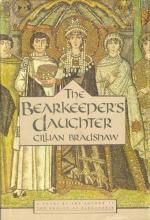|
This section contains 131 words (approx. 1 page at 300 words per page) |

|
The Bearkeeper's Daughter, like its predecessor, The Beacon at Alexandria (1986), is well-researched historical fiction that imaginatively presents a graphic picture of a relatively littleknown period. Bradshaw avoids archaic language, and both descriptions and dialogue use a modern style, which successfully evokes the ancient scene.
Unlike The Beacon at Alexandria, this novel does not use first-person narration. Although Bradshaw presents the viewpoint of John throughout the novel, she uses a third-person narrative voice. When she wants to communicate John's private thoughts, she does so in italicized passages. This produces an effective balance of objective and subjective narration.
Bradshaw's approach to historical fiction is somewhat similar to that of Mary Renault, whose novels about ancient Greece use the modern idiom to evoke that culture and its myths.
|
This section contains 131 words (approx. 1 page at 300 words per page) |

|




